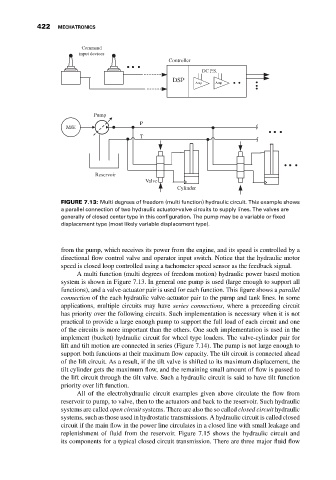Page 436 - Mechatronics with Experiments
P. 436
JWST499-Cetinkunt
JWST499-c07
422 MECHATRONICS Printer: Yet to Come October 9, 2014 8:41 254mm×178mm
Command
input devices
Controller
DC P.S.
DSP
Amp Amp
Pump
P
M/E
T
Reservoir
Valve
Cylinder
FIGURE 7.13: Multi degrees of freedom (multi function) hydraulic circuit. This example shows
a parallel connection of two hydraulic actuator-valve circuits to supply lines. The valves are
generally of closed center type in this configuration. The pump may be a variable or fixed
displacement type (most likely variable displacement type).
from the pump, which receives its power from the engine, and its speed is controlled by a
directional flow control valve and operator input switch. Notice that the hydraulic motor
speed is closed loop controlled using a tachometer speed sensor as the feedback signal.
A multi function (multi degrees of freedom motion) hydraulic power based motion
system is shown in Figure 7.13. In general one pump is used (large enough to support all
functions), and a valve-actuator pair is used for each function. This figure shows a parallel
connection of the each hydraulic valve-actuator pair to the pump and tank lines. In some
applications, multiple circuits may have series connections, where a preceeding circuit
has priority over the following circuits. Such implementation is necessary when it is not
practical to provide a large enough pump to support the full load of each circuit and one
of the circuits is more important than the others. One such implementation is used in the
implement (bucket) hydraulic circuit for wheel type loaders. The valve-cylinder pair for
lift and tilt motion are connected in series (Figure 7.14). The pump is not large enough to
support both functions at their maximum flow capacity. The tilt circuit is connected ahead
of the lift circuit. As a result, if the tilt valve is shifted to its maximum displacement, the
tilt cylinder gets the maximum flow, and the remaining small amount of flow is passed to
the lift circuit through the tilt valve. Such a hydraulic circuit is said to have tilt function
priority over lift function.
All of the electrohydraulic circuit examples given above circulate the flow from
reservoir to pump, to valve, then to the actuators and back to the reservoir. Such hydraulic
systems are called open circuit systems. There are also the so called closed circuit hydraulic
systems, such as those used in hydrostatic transmissions. A hydraulic circuit is called closed
circuit if the main flow in the power line circulates in a closed line with small leakage and
replenishment of fluid from the reservoir. Figure 7.15 shows the hydraulic circuit and
its components for a typical closed circuit transmission. There are three major fluid flow

